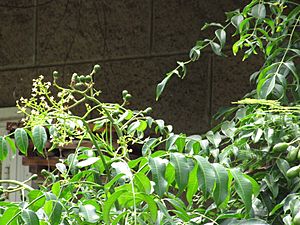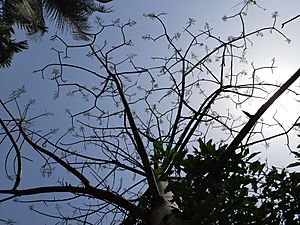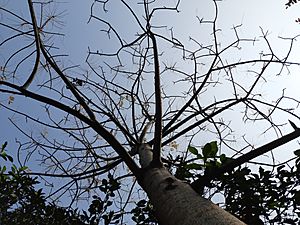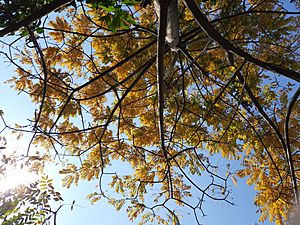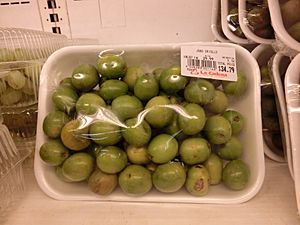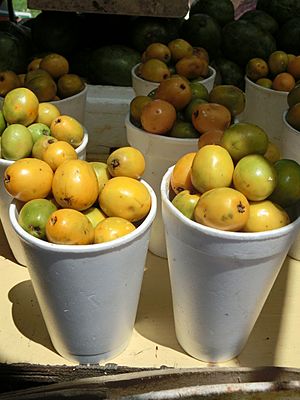Yellow mombin facts for kids
Quick facts for kids Yellow mombin |
|
|---|---|
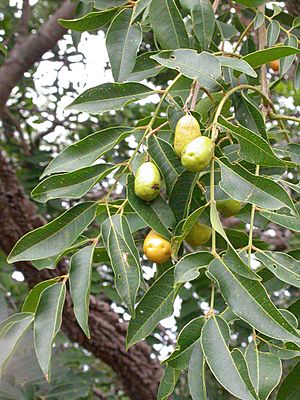 |
|
| S. mombin, fruiting | |
| Conservation status | |
| Scientific classification | |
| Genus: |
Spondias
|
| Species: |
mombin
|
| Synonyms | |
|
|
Spondias mombin, also known as the yellow mombin or hog plum, is a type of tree. It is a flowering plant in the Anacardiaceae family. This tree originally comes from the warm, tropical parts of the Americas. This includes the West Indies. Portuguese explorers brought the tree to South Asia in the early 1600s. Now, you can find it growing naturally in parts of Africa, India, Nepal, Bangladesh, Sri Lanka, and other Caribbean islands. It is not grown very often, except in some areas of Brazilian Northeast. The ripe fruit has a tough skin and a thin layer of soft fruit inside. The seed of the fruit contains about 31.5% oil.
Contents
What is the Yellow Mombin Tree Like?
The Spondias mombin is a small tree. It can grow up to 20 meters (66 feet) tall. Its trunk can be about 1.5 meters (5 feet) around. The tree has thick, corky bark with deep cracks. If you cut the bark, it looks light pink. It quickly turns darker. Its branches grow low to the ground. The smaller branches are smooth.
The leaves of the tree are made of smaller leaflets. There are usually 5 to 8 pairs of leaflets. Each leaflet is about 10 by 5 centimeters (4 by 2 inches). They are shaped like an oblong or spearhead. They are also smooth. The tree's flowers bloom from January to May. They smell sweet. These small white flowers grow in large, loose clusters. The fruits appear from July to September. They are about 4 centimeters (1.6 inches) long. They are oval-shaped and yellow. When dry, they look wrinkled. The fruits taste sharp and a bit sour. They are safe to eat. Inside the fruit's flesh is a single, spiny seed.
Eating the Yellow Mombin Fruit
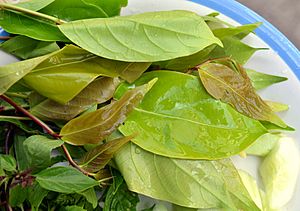
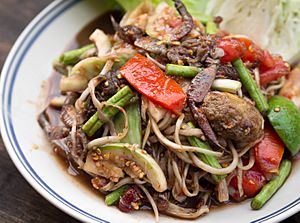
People eat the fruit pulp fresh. They also use it to make juice. It can be made into a thick concentrate. Sometimes, it is used to make jellies. It is also used for sherbets, which are sweet drinks.
In Thailand, this fruit is called makok. It is used in a dish called som tam. This is a spicy salad. The young leaves of the tree are also eaten. They taste a little bitter and sour. They are sometimes served raw with Thai chili pastes. In Bangladesh, the fruit is called amṛa. It is served with chili powder there. In India, it is known as Amado in Konkani. It is called omora in Assamese. In Nepal, this fruit is called lapsi.
The yellow mombin is part of the sumac family. This family also includes plants like poison ivy. Some people are sensitive to a substance called urushiol. This substance is found in plants like poison ivy. If you are sensitive to urushiol, you should be careful. Touching or eating parts of this tree might cause a similar skin reaction.
Traditional Uses of Yellow Mombin
For a long time, people have used Spondias mombin in traditional medicine. The fruit has been used to help the body get rid of extra water. It was also used to help reduce fever. The bark of the tree is known to tighten tissues. It was used to help with upset stomachs. It was also used for diarrhea and other issues. People made tea from the flowers and leaves. This tea was used for stomach aches. It was also used for other types of inflammation.
Different Names for the Yellow Mombin
The Spondias mombin has many common names. In most Spanish-speaking Caribbean countries, it is called jobo. This name comes from the Carib language. In Cuba and northern Mexico, it is called ciruela. In Costa Rica, it is known as yuplón. This name comes from the English name gully plum. In El Salvador, it is called Jocote de Corona.
In English-speaking Caribbean islands, it is called yellow mombin or hog plum. In Jamaica, it is also known as Spanish plum, gully plum, or coolie plum. In Surinam, the fruit is called Mope. In Brazil, it has several names. These include cajá, taperebá, and ambaló. In Peru, it is called uvos or mango ciruelo. In Ghana, it is known as hog plum or Ashanti plum. In the Ewe language of Ghana, it is called "Akukor".
In Bengali, it is called আমড়া (Amṛa). In Kerala, a state in southern India, it is called Ambazhanga അമ്പഴങ്ങ. In Kannada, it is called AmateKaayi. In Goa, it is known as 'Ambadde'. In Nigeria, the fruit has many names. These include Ughighen in the Urhobo language. It is Iyeye or Yeye in the Yoruba language. It is ngulungwu in Igbo. In Hausa, it is isada. Other common names are hug plum, true yellow mombin, golden apple, or Java plum. In Sri Lanka, it is called Ambaralla (ඇඹරැල්ල). In Somalia, it is called Isbaandes. In Panama, it is called jobo. In Palauan, it is called titimel. In Telugu, it is called neredupandu or neredukaya.
See also
 In Spanish: Spondias mombin para niños
In Spanish: Spondias mombin para niños




